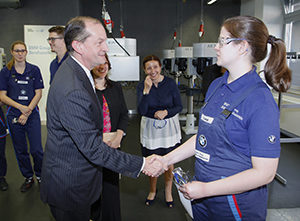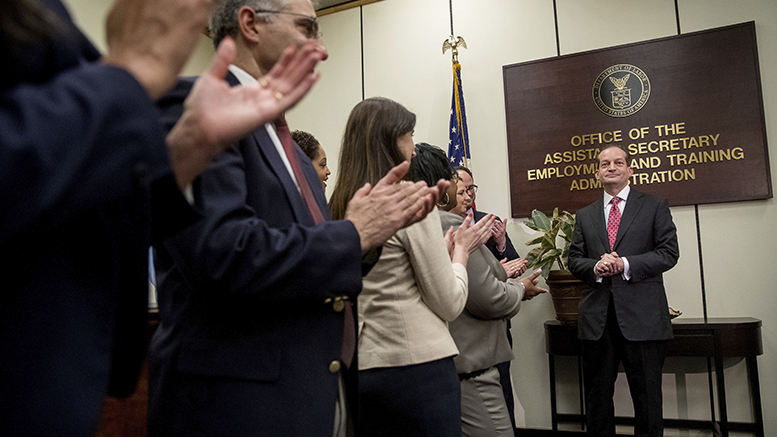U.S. Labor Secretary Alexander Acosta on Friday made public-private apprenticeships his debut issue as President Trump’s point man on matching American workers with specific jobs.
“CEO after CEO has told me that they are eager to fill their vacancies, but they cannot find workers with the right skills,” Acosta told the labor ministers of the Group of 20 industrial and emerging-market nations gathered in Germany. Apprenticeships that pay salaries and often lead to careers, he added, “are a major priority for President Trump and the Department of Labor.”
The declaration, and a new campaign of tweets on the subject, represent the first indication since Acosta’s swearing-in three weeks ago that apprenticeships are at the core of the Trump administration’s plans to train a new generation of workers.
A closer look at apprenticeships
The discussion of apprenticeships is a relatively new one for Trump, who campaigned for the White House on promises to restore manufacturing jobs that he said had been lost to flawed trade deals and unfair competition from China, Mexico and more.
But it’s not new to policymakers of either party or the private sector, whose leaders have for years run apprenticeship programs. Some are modeled on those in such countries as Germany and the United Kingdom.
In a discussion in February, some of the two dozen CEOs gathered to discuss manufacturing jobs suggested there were still plenty of openings but too few qualified people to fill them. One executive said his company has 50 participants in a factory apprenticeship program, but could take 500 if enough were qualified.
Unemployment is historically low, but there are gaps in some sectors. Government figures show there are 324,000 open factory jobs nationwide – triple the number in 2009, during the depths of the recession.
What business leaders want
At a White House round table discussion, some executives challenged Trump to generate a “moonshot” of 5 million new apprenticeships over five years.
“Our companies are some of the greatest universities in the world. We shape these employees, we train them, we educate them, we bring them in,” said Salesforce.com CEO Marc Benioff, who issued the challenge to Trump.
“Let’s do that, let’s go for that 5 million,” Trump replied at the event in March.
There’s also evidence of rare bipartisan agreement, at least on the value of apprenticeships, which generally combine state and federal government money with support from universities and companies looking to train people for specific jobs. In some cases, students split their time between school and work, and the companies pay some portion of wages and tuition.
The budget compromise funding the federal government through September passed this month with $95 million for apprenticeship grants, an increase of $5 million – in part to increase the number of women apprentices.

Labor Secretary Alexander Acosta meets BMW apprentices at a technical apprentice training workshop. (Photo: U.S. Department of Labor)
“@POTUS & I are focused on boosting the number of women who participate in apprenticeship programs,” Acosta tweeted from Germany last week. While there, Acosta toured the BMW assembly plant in Munich. The company has an apprenticeship program in Spartanburg, South Carolina, with three community colleges in the area.
Trump’s “skinny” – or abbreviated – budget blueprint released in March proposes a 21 percent cut in the Labor Department budget, but also pledges to help states expand apprenticeship, an evidence-based approach to preparing workers for jobs. His more detailed budget is due out on May 23.

